I was visiting the #Camp2023 this year from 14th to 19th of August 2023 in Mildenberg, Brandenburg, Germany or how it is officially named, the Chaos Communication Camp, the outdoor hacker camp by the well known Chaos Computer Club.
I never wrote a blog post about the camps I visited in 2015 and 2019, because they were both awesome and I did not want to ruin my memories about them. But this time it was different for me and I’d like to share why.
vorfreude
I admit it, I was euphoric to visit the camp again. After an endless time of no chaos events at all (Chaos Congress 2022 was postponed last minute because of COVID-19), I thought this might be the next event I’d have to visit. COVID-19 created a void that felt to become bigger each year. I really wanted to visit this camp because I was lacking the contact to several people I only see at these events.
At the same time I was stressed out by not having had any serious vacation for several months in my job as an IT employee. I was already very exhausted when I decided to contribute to the camp by helping the Bits & Bäume village to thrive at the camp.
I think it was my strong wish for some self-efficacy which made me work on a contribution to Bits & Bäume that was unique and challenging at the same time.
a bits & bäume village sign
the idea
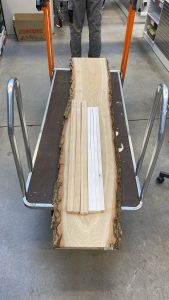 When the planning process for the village finally settled for an area, it seemed to be a very good idea to have some kind of sign and/or installation, that would help direct participants of the camp to the bits & bäume area. Since the village was located outside of the ‚regular‘ (access control was only provided for inside of the fence) camp area, we would need to attract participants on the inside of the area to take a walk to the outside.
When the planning process for the village finally settled for an area, it seemed to be a very good idea to have some kind of sign and/or installation, that would help direct participants of the camp to the bits & bäume area. Since the village was located outside of the ‚regular‘ (access control was only provided for inside of the fence) camp area, we would need to attract participants on the inside of the area to take a walk to the outside.
Since I had recently seen a nice NEON-glowing sign created from LED’s, I offered to build such a sign for the village. On the one hand side the sign would nicely glow & work in the dark controlled by a microcontroller (bits), but it also would blend perfectly with a piece of wood (bäume), which shows a nice contrast between nature & technology united.
materials
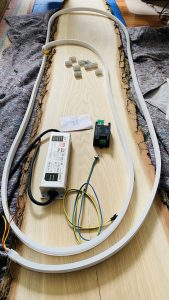 To start my challenge I went to the Bauhaus and bought a really big piece (200 x 40 cm) of wood. I was astonished that Bauhaus sells these very natural pieces of wooden board. I picked one out of several which had a nice bark. Since the board was huge in size, I needed to fiddle with one of my cars front seats to get the board to fit for transportation. That way the first transport of this big piece of wood from Bauhaus to home went smoothly. Sooner or later it should be transported all the way east from Bremen to Mildenberg via the autobahn.
To start my challenge I went to the Bauhaus and bought a really big piece (200 x 40 cm) of wood. I was astonished that Bauhaus sells these very natural pieces of wooden board. I picked one out of several which had a nice bark. Since the board was huge in size, I needed to fiddle with one of my cars front seats to get the board to fit for transportation. That way the first transport of this big piece of wood from Bauhaus to home went smoothly. Sooner or later it should be transported all the way east from Bremen to Mildenberg via the autobahn.
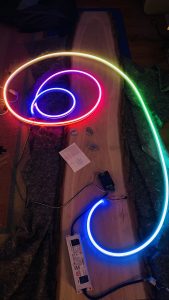 Next I ordered 5 meters of LED-tube from ZEDFY (Datenblatt PDF). I also ordered their WLED-microcontroller, a fitting 12V power supply and a piece of cable to connect both, as also some aluminum clamps to attach the LED tube to the wooden underground. The power supply is more powerful than actually needed, but I wanted the power supply to have a metal casing instead of plastic and thus went for the bigger one. All parts arrived quickly and in pretty good shape. This was already a huge success, because there were only 7 days left until camp. If for some reason the delivery would have been delayed, it would have been impossible to finish the sign in time.
Next I ordered 5 meters of LED-tube from ZEDFY (Datenblatt PDF). I also ordered their WLED-microcontroller, a fitting 12V power supply and a piece of cable to connect both, as also some aluminum clamps to attach the LED tube to the wooden underground. The power supply is more powerful than actually needed, but I wanted the power supply to have a metal casing instead of plastic and thus went for the bigger one. All parts arrived quickly and in pretty good shape. This was already a huge success, because there were only 7 days left until camp. If for some reason the delivery would have been delayed, it would have been impossible to finish the sign in time.
text & font
 The styleguide for the camp23 revealed some interesting font choices to be used for this camp. I found the colors which were chosen pretty nice and using a stencil font does not happen that often. It gave the whole textual stuff a more urban feel and the stencil font was perfect to be rendered as a neon glowing sign – but the amount of work which would be necessary to make this thing a reality was completely underestimated by me.
The styleguide for the camp23 revealed some interesting font choices to be used for this camp. I found the colors which were chosen pretty nice and using a stencil font does not happen that often. It gave the whole textual stuff a more urban feel and the stencil font was perfect to be rendered as a neon glowing sign – but the amount of work which would be necessary to make this thing a reality was completely underestimated by me.
 At first I thought I should try different script like fonts, so I created a proof of concept image that displayed a script font. But I quickly recognized that this was not the way to move forward, because it would have just been too complicated to arrange all the curves of the font.
At first I thought I should try different script like fonts, so I created a proof of concept image that displayed a script font. But I quickly recognized that this was not the way to move forward, because it would have just been too complicated to arrange all the curves of the font.
the BEON font
The basic idea was to have the text „BITS & BÄUME“ with the stencil font „Beon“ put on a wooden board like displayed in this arranged proof of concept. This looked way more doable than a script font. The first difficulty was, how to get the text on the board. I decided to use a mini beamer I had ready to use to project the text directly onto the wooden board. For this I created a special image just to project it.
 It had to be black and white so that I could see the white text on the board.
It had to be black and white so that I could see the white text on the board.
transfer to board
 I transferred the text with some pencil to the board character by character.
I transferred the text with some pencil to the board character by character.
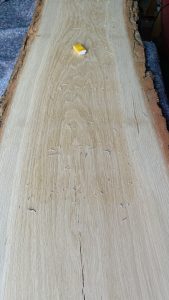 Just to remove all the drawn lines one hour later. Because when I had a closer look to the LED-tube, I recognized, that I could only cut the tube every 5 centimeters, because logically 3 LEDS were unionized to one programmable unit. This meant all the characters had to be built with LED-strips having a multiple of 5 centimeters length.
Just to remove all the drawn lines one hour later. Because when I had a closer look to the LED-tube, I recognized, that I could only cut the tube every 5 centimeters, because logically 3 LEDS were unionized to one programmable unit. This meant all the characters had to be built with LED-strips having a multiple of 5 centimeters length.
the 5cm limitation
 The cut open piece of LED tube displays how the LEDs are arranged inside of the tube. This was a real bummer to me, because now I had to find a way how to craft every character with strips that needed to be a multiple of 5 cm in length.
The cut open piece of LED tube displays how the LEDs are arranged inside of the tube. This was a real bummer to me, because now I had to find a way how to craft every character with strips that needed to be a multiple of 5 cm in length.
 I ended up measuring the length of each character already drawn on the board to get an idea of how I could adjust the scaling of the whole string to get the best fit to a multiple-of-5 approach. I found that the perfect height e.g. for the letter „I“ was 15 cm. From there I tried to interpolate the remaining pieces for all the other characters to best fit to there original values measured. This should at least provide a basic possibility to form most of the characters without too much painful corrections.
I ended up measuring the length of each character already drawn on the board to get an idea of how I could adjust the scaling of the whole string to get the best fit to a multiple-of-5 approach. I found that the perfect height e.g. for the letter „I“ was 15 cm. From there I tried to interpolate the remaining pieces for all the other characters to best fit to there original values measured. This should at least provide a basic possibility to form most of the characters without too much painful corrections.
starting with a „B“
 After finding out the target projection needed to be scaled down by roughly 16% to make the characters fit to the new 15 cm in height limitation, I reprojected everything and again put the characters on the board with a pencil. I was really annoyed that I had to actually redo everything again, erase the old pencil drawings on the wooden surface, setup the beamer again, exactly adjust the projection and measure closely all the character heights. As soon as the transfer was ready I started cutting the first character „B“ and wired it up to power and the data line of the LED-controller.
After finding out the target projection needed to be scaled down by roughly 16% to make the characters fit to the new 15 cm in height limitation, I reprojected everything and again put the characters on the board with a pencil. I was really annoyed that I had to actually redo everything again, erase the old pencil drawings on the wooden surface, setup the beamer again, exactly adjust the projection and measure closely all the character heights. As soon as the transfer was ready I started cutting the first character „B“ and wired it up to power and the data line of the LED-controller.
 The „B“ was the first character where I could actually see that my calculations of the multiple-of-5-cm-strips actually worked well. The first glow in the dark made me really upbeat about continuing the work. But at the same time I also recognised how much work it really was to place the strips and connect them after cutting them in pieces. Every cut would mean to cut 3 lines of copper wire to the perfect length and solder those with 6 connections, so the strip is connected to power and data.
The „B“ was the first character where I could actually see that my calculations of the multiple-of-5-cm-strips actually worked well. The first glow in the dark made me really upbeat about continuing the work. But at the same time I also recognised how much work it really was to place the strips and connect them after cutting them in pieces. Every cut would mean to cut 3 lines of copper wire to the perfect length and solder those with 6 connections, so the strip is connected to power and data.
BITS
 I was able to also find proper solutions for the following characters. The „I“ was easy, but the „T“ already needed a new solution to how the character would be formed with LED-tube. When I reached the „S“ I was already like „Whoa, this is so much work, I will not cut the S in small pieces“.
I was able to also find proper solutions for the following characters. The „I“ was easy, but the „T“ already needed a new solution to how the character would be formed with LED-tube. When I reached the „S“ I was already like „Whoa, this is so much work, I will not cut the S in small pieces“.
 So I went with a single strip for the whole „S“ instead. I also ran out of aluminum clamps to put the tube on the board. I knew that this would happen already a day earlier and had ordered more clamps (ca. 50 additional) a day earlier but those still needed to arrive in time to make the rest of the sign a reality.
So I went with a single strip for the whole „S“ instead. I also ran out of aluminum clamps to put the tube on the board. I knew that this would happen already a day earlier and had ordered more clamps (ca. 50 additional) a day earlier but those still needed to arrive in time to make the rest of the sign a reality.
Getting to the „E“ like end
 I was cutting the LED-tube, placing the strips, screwing the aluminum clamps, measuring the length the next 3 copper wires would need, cut the wires, and solder the next 6 connections. This was basically the crazy work I needed to do with lots and lots of cuts and connections.
I was cutting the LED-tube, placing the strips, screwing the aluminum clamps, measuring the length the next 3 copper wires would need, cut the wires, and solder the next 6 connections. This was basically the crazy work I needed to do with lots and lots of cuts and connections.
 Overall I had to connect 28 different pieces, which makes for 168 connections to be soldered and 84 lines of wire to be cut and connected. This was just crazy! I totally underestimated how much damn work this would be. But hey, the „E“ of „BÄUME“ was finally placed and just needed soldering.
Overall I had to connect 28 different pieces, which makes for 168 connections to be soldered and 84 lines of wire to be cut and connected. This was just crazy! I totally underestimated how much damn work this would be. But hey, the „E“ of „BÄUME“ was finally placed and just needed soldering.
First light
 So finally after several shifts of soldering – I went with soldering 3 characters and then had a pause again – the sign was in the late evening in a state of „first light“. All characters were finally lighting up. By the way the ampersand was really the most annoying character to build and solder. It was also the character where I went out of flexible copper wires and tried more rigid copper wires, which broke off the connections I had soldered the moment I wanted to place them properly on the board. I cannot recommend rigid copper wire to be used for this purpose.
So finally after several shifts of soldering – I went with soldering 3 characters and then had a pause again – the sign was in the late evening in a state of „first light“. All characters were finally lighting up. By the way the ampersand was really the most annoying character to build and solder. It was also the character where I went out of flexible copper wires and tried more rigid copper wires, which broke off the connections I had soldered the moment I wanted to place them properly on the board. I cannot recommend rigid copper wire to be used for this purpose.
The next hour I was just sitting in front of this sign and playing around with the configuration options of the controller. The first non-obvious thing was the amount of LEDs to configure for the power-budget feature of the controller. It took me some time that I actually needed to calculate with ONE LED per 5 cm to make the whole data-logic work the way it should. The great thing I found out after nearly an hour running through different effects, was the possibility to define segments running different effects.
This made it easily possible to configure different colors for actually each character if needed. I went with 3 segments for the beginning to make the two words and the ampersand light up in their own colors respectively.
Arrival at the camp
I started way too late towards camp. Actually the work on the sign delayed my arrival by 2 full days. And I was pretty exhausted already after I had packed everything in the car and started towards Mildenberg. When I left the autobahn near Oranienburg, I had to also find a gas station to refill the fuel tank of my car. But around this time 2100 in this rurual area only one gas station still had open hours. And this one was not so easy to find and stressed me out a little bit. It meant that I lost even more time arriving. There went my plans directly south of arriving at daylight to find a nice spot for the tent. I was pretty much done when I arrived at the camp site.
The gate
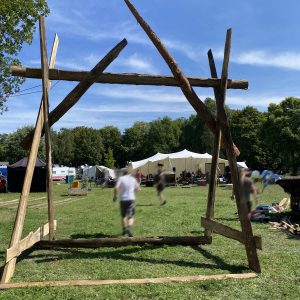 On arrival I was amazed by what the village had already accomplished in regard to building a wooden gate. Since it was already very dark on my arrival, I just was able to quickly fire up the sign once and then was just plain exhausted.
On arrival I was amazed by what the village had already accomplished in regard to building a wooden gate. Since it was already very dark on my arrival, I just was able to quickly fire up the sign once and then was just plain exhausted.
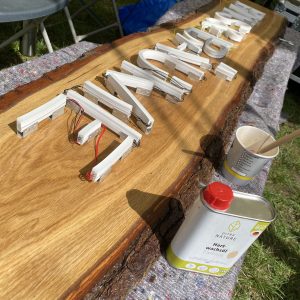 The next day the gate was erected and wow it looked really great. There was still some work to do on the gate and on the sign. The sign should hang from the top of the gate to direct the crowds towards „Bits & Bäume“ village. But for the sign to be placed there, the sign itself needed still some work.
The next day the gate was erected and wow it looked really great. There was still some work to do on the gate and on the sign. The sign should hang from the top of the gate to direct the crowds towards „Bits & Bäume“ village. But for the sign to be placed there, the sign itself needed still some work.
The power-supply and the emergency-off-switch needed to be screwed on the back of the sign and put in proper water protection. Also the still open ends of the LED-tube needed to be closed with silicone and the wood needed to be protected against water with some biological water protection coating.
The Sign
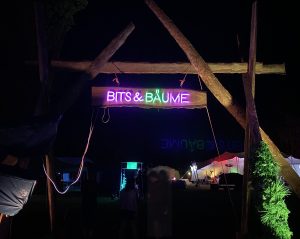 At the end of a very long day of more work on the gate and the sign, we finally managed to put up the sign with some ropes to find the correct location and height. First we tried to attach it with rope, we had an expert among us who kew all kind of safe knots to attach it. But the available ropes were not that trustworthy to us.
At the end of a very long day of more work on the gate and the sign, we finally managed to put up the sign with some ropes to find the correct location and height. First we tried to attach it with rope, we had an expert among us who kew all kind of safe knots to attach it. But the available ropes were not that trustworthy to us.
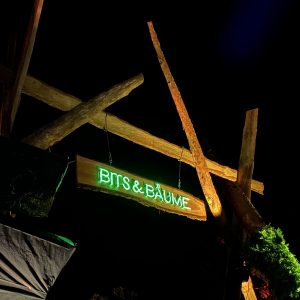 Then someone suggested to use safety steel-ropes which are usually used to secure light installations on professional stages. We had some of those as part of our stage equipment. So we finally found a nice looking and safe way to attach the sign on top of the gate. This was looking better than I could have imagined. The gate was a really welcoming structure to mark the entry to our village. Without the gate it would have just been „some tents in the back on the green“ but the gate gave a clear indication „now you enter the bits & baeume village“.
Then someone suggested to use safety steel-ropes which are usually used to secure light installations on professional stages. We had some of those as part of our stage equipment. So we finally found a nice looking and safe way to attach the sign on top of the gate. This was looking better than I could have imagined. The gate was a really welcoming structure to mark the entry to our village. Without the gate it would have just been „some tents in the back on the green“ but the gate gave a clear indication „now you enter the bits & baeume village“.
Gate details
The gate got some nice functional decoration before it went into full operation. On the left side two screens were installed running the Infobeamer software package installed on two Raspberry PI’s. The left side was meant to represent the digital aspects. On the right we tried to represent the natural, biological side of the village name. Several lights made the final installation really shine.
The Damage
 To my regret the sign was severely damaged not even 24 hours after it was successfully installed (see image above, which only allowed the sign to glow in blue colors for the remaining days of the camp). Some idiot with a 3-wheel-e-scooter and a long steel pole flag attached to the vehicle, crashed in the sign and ruptured the copper wires and contacts on the first „B“-character in a way that repair could only partially be applied and just fixed the power supply to the sign. The data wire was impossible to be reattached due to the made damage to the LED-tube.
To my regret the sign was severely damaged not even 24 hours after it was successfully installed (see image above, which only allowed the sign to glow in blue colors for the remaining days of the camp). Some idiot with a 3-wheel-e-scooter and a long steel pole flag attached to the vehicle, crashed in the sign and ruptured the copper wires and contacts on the first „B“-character in a way that repair could only partially be applied and just fixed the power supply to the sign. The data wire was impossible to be reattached due to the made damage to the LED-tube.
A message to this person.
You damaged a piece of work in seconds which took days of precise work to be completed by many people with compassion. Do you feel excellent about this? But you know what, I think it is not worth that I get into rage about a person like you are. What did you actually provide to the camp? I am not the one to judge about you using a Pesthoernchen-flag as some folklore decoration to your steel-pole-flag damaging things. History will judge you about this. – This maybe looks like I have a rage management issue, but I was really upset about how this person reacted and it did hurt me.
The village
Finally I really liked being part of our village. Even though I was stressed out most of the time, I was happy I could contribute a tiny piece to the overall village experience of the camp participants. It was worth the effort and I would like to say a big thank you to the village team.
Camp 2023 post-mortem
no mediawiki
In the past most of the big Chaos events (like Chaos Communication Congress and Chaos Communication Camp) made heavy use of the MediaWiki open-source software. The wiki installation was THE go-to-place where to find latest and up-to-date information about the event. And all the stuff that was not to be found there was linked/referenced there.
One big advantage of using MediaWiki over everything else is the democratic access which allows everyone to participate. You just needed an account (just this ONE account in the MediaWiki installation) and you were able to edit and extend the content and be a vital part of the decentralized self-organizing chaos. You could register yourself for a lightning talk e.g., you could add yourself a user profile with links to projects and your own hackerspace, you could register and setup assemblies and villages (through a plugin for MediaWiki that enabled FORMS for more complex data entries).
Also the MediaWiki has a well known way how to edit content (if you edited a Wikipedia entry once, you know how to use it). Yes it has some specific syntax which is not so nice to first time users, but for all people who did not like the syntax there was a WYSIWYG-editor available and you could easily learn the syntax by just opening other pages in edit-mode and see the source code that revealed the syntax used.
static hierarchy
This time it was very different, and to my experience way worse. The general purpose application of MediaWiki was replaced by some self-written python/Django software still in its infancy called the „hub“ (see screenshots below). That software introduced hierarchy in the users and their accounts in a way that NOT any longer everyone could easily register and edit. The process of becoming a hub member became a clandestine thing of registering an account and then having some „admin“ allowing you access to one specific part of the software representing that camp village you are associated with.
So not only was a mature solution like the wiki exchanged by some immature new custom made piece of software, it also introduced control & hierarchy and silos of information. This to me is the exact opposite of how chaos works.
This was the only wiki left (just an alibi wiki):

It looks as if some enterprise software solution was the blueprint for the „hub“. I do not get where actually even the tiniest thing is improved by introducing the „hub“. But I do see where lots of cultural knowledge and democratic self-organizing structure was lost by introducing the hub. This I see as a warning sign for the chaos community because some people apparently decided that less chaos is better than more chaos and that more hierarchy is better than no hierarchy.
I know the MediaWiki installation has had its difficulties to be made performant for thousands of requests hitting the servers. And also that MediaWiki is not that easy to customize/theme. But even a very bad performing MediaWiki would have been way better than the „hub“ from my point of view. The „hub“ enforces a certain hierarchy of information and thinking and disallows the free association of information. It is a very special purpose application that is still in its infancy and does not provide the needed freedom of expression and organization.
I am deeply disappointed by this development and I decline to use the „hub“ as a „replacement“ for the general purpose MediaWiki which it definitely isn’t.
camp experience
My camp experience this time was pretty different to 2015 and 2019. The first thing I noticed was that actually the whole place was really packed with people. There was literally no place left to put another tent there. The additional 1000 tickets sold had a significant impact to the overall experience.
The first thing I noticed was, that there apparently was setup a two-class-society/-community: the hackers inside of the fence of the Ziegeleipark and the ones outside of the fence. Access control was only enforced when you entered the area inside of the fence. The additional 1000 tickets sold did not represent the amount of people which actually came.
the children & caravan camp
In 2019 there was a dedicated kids & parents area for camping. They had dedicated infrastructure like showers & toilets and were put in a place next to the kids facilities and the zoo of the Ziegeleipark. Kids did not count as participants but were accepted to be brought to the camp.
This year the situation was rather different. The first noticeable change was that way more caravans were allowed to enter the area. This at the same time reduced the available space for tents a lot. And then those people coming with a caravan were most likely also bringing their kids. They were not camping in the dedicated kids area but instead in the caravan area.
This has two noticeable impacts:
- kids were literally everywhere, on the train, on the dancing grounds, on the roads, crying in the early morning, crying in the early evening. I have seen 3-year olds running with their pampers on the roadways of the camp. The camp ground is also heavily used by human powered vehicles like scooters and bikes. So you had to be extra-extra careful not to run accidentially over a three-year-old crossing the street.
- from the 1000 additional tickets sold a solid number of ticket-owners would also bring their kids. So if you allow 6000 tickets to bring their kids, they will just do it. And that is what happened and from my point of view escalated this year. I would estimate a number of 350 to 450 kids were on the camp ground. The thing is, the infrastructure for freshwater, showers and toilets was highly likely just planned to work for 5000 people. The amount of infrastructure was from what I could recognise nearly the same as in 2019, and it just did not scale.
defect infrastructure
Starting already on day 2 more and more toilets went out of order / defect and were not repaired. Also the showers started to degrade massively in the north-eastern part of the camp to the point where actually no water at all was available from the shower anymore. I experienced this firsthand and went by bike to the western-most side of the camp ground to find a working shower (btw. there the water pressure was so high, that a lot of water was wasted for sure – don’t there exist water pressure limiters?).
To me the degrading toilets – more and more toilets went out of order and the existing ones were very dirty up to the point where you were unable to really use them anymore – were the most disgusting experience I ever had in an outdoor event. The amazing thing was that nothing was repaired, instead just a „DEFECT/OUT OF ORDER“ sign was placed on the defective piece of infrastructure. Since I was forced to use that infrastructure at least 3 times per day, it was a part of my experience I could not bypass or easily route around. It made the camp to me a personally disgusting experience.
silent camping
One thing future camps should really consider is emission of sound. I had the strong impression, that this year even more sources of sound/noise were setup (see map). There were times where at least in 7 different places there was nearly the same type of music (techno/electro/dnb) running. Depending on where you were you heard a cacophony of sounds from different places. I think less stages for music but rather high quality stages would be a way better choice for the future. And then put all the music areas in a dedicated place which is already loud by design (e.g. marketplace).
There was no real silent area even though one was labelled silent camping. I think for a good camp experience there should be also silence for several hours per day – but maybe I am just getting too old for this. At least in one dedicated place. This was a very difficult to find place this time. I think this should strongly be reconsidered next time.
missing infrastructure
I know that the huge tents which were installed 2019 were considered to be too big. But the solution we had this year – to use open tarps instead of real tents for stages, was not a very good idea. Since the tarps did not provide enough shelter and protection against weather, stage programs needed to cancel/abort/shut down as soon as some rains was coming.
 Also the open tarp did make the beamer screens unreadable due to the sunlight entering the stage at all times. Also the open stages under the tarps did only provide very limited facilities for seating. This was very disappointing! I visited several Milliways talks and experienced first hand that seating was a big problem and also light conditions made slides of speakers unreadable.
Also the open tarp did make the beamer screens unreadable due to the sunlight entering the stage at all times. Also the open stages under the tarps did only provide very limited facilities for seating. This was very disappointing! I visited several Milliways talks and experienced first hand that seating was a big problem and also light conditions made slides of speakers unreadable.
But I was also missing workshop tents which could be booked in a self-organized way. I was prepared to give a nice workshop on building a little tabletop-lamp called FireFairy but since the mediawiki was not there and the workshop tents were not there I just did not give my workshop. I just saw no opportunity to do it.
be excellent to each other: the good things
I did find some very nice artwork after the camp here by Mat Brady. Really nice work built with blender.
There is also a strong decline in blogging from my point of view, or the search engines just do not scrape the blogosphere anymore. I just found korrupt blogging about it and korrupt referring to stk blogging about the camp. I did not read korrupt’s blog entries until I had my entry finished. But I was surprised to see, he also identifies the missing MediaWiki as a blocker for more chaotic engagement. I tell myself now that I am just getting old and that culture is a fluid thing. This is the point where I want to refer to my disclaimer again.
More blog reviews / links / snippets found on the interwebz
- I found also a nice Rueckblick from Jugendhackt
- Another interesting blog entry in russian language can be found here at the blog of Vastrik who is sharing a lot of pictures/photos.
- FabLab Lueneburg also blogging a bit
- Makerspace Partheland e.V. blogs here.
- The Verstehbahnhof has also a small blogposting
- The Verbund Offene Werkstaetten has also a small entry
- Digital Courage did share some impressions
- Review of Chaostreff Flensburg
- A shared photo by chaotikum
- a shared photo by correctiv
- A short review by PEASEC group at university of Darmstadt
- some nice photos of light installations by night from kasiandra
- hacklab helsinki
- some DJ sets from Camp 2023
- photos on flickr by binhacken
- photos on flickr by leahoswald
- Zwischen den Welten, im Sommer, Blog-Post
- CCC Camp 23, Blog-Post
- Zwischen Ziegelöfen und Leuchtkugeln: Das Linked Open Data Village, Blog-Post
the streams
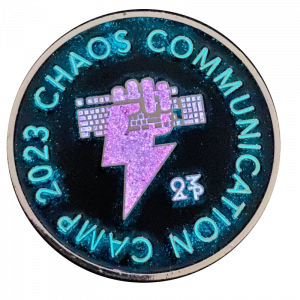 To me the megaasset of the camp & chaos infrastructure were the streams & content recording. The recording and broadcasting of the streams was essential, since seating in front of stages was so limited. Also the recording allows to rewatch the slides which were most of the time so difficult to read in sunlight that only in the stream you could read that stuff clearly. Big thanks to the VOC and all the angels working on this which from my point of view did an awesome job here.
To me the megaasset of the camp & chaos infrastructure were the streams & content recording. The recording and broadcasting of the streams was essential, since seating in front of stages was so limited. Also the recording allows to rewatch the slides which were most of the time so difficult to read in sunlight that only in the stream you could read that stuff clearly. Big thanks to the VOC and all the angels working on this which from my point of view did an awesome job here.
Update 17.9.2023: recommended recordings
I have been watching several recordings of the camp, some while I was still at the camp via the Re-Live feature that is awesome (thanks VOC), some later at home. My primary way to watch the recordings was through the iOS Chaos Communication Camp app. Thanks again to Thomas for providing the app and updating all the relevant data sources to make this work. I know how much tedious work this can be, as I have provided apps for congress more than once.
The app provides to me the following advantage compared to using the media.ccc.de website directly:
- Only the recordings of the camp are displayed. This is actually helpful, on media.ccc.de you need to click through the events list and then select Camp23 to reduce the amount of hits to camp content only.
- I could start playing the video on the iDevice and could easily transfer playing of it to the Apple TV (via AirPlay). This is very convenient!
- The app does the book keeping which recordings I have already seen.
 To my regret the Apple TV CCC app was never updated after the initial release and is not working / defect for several years now. Apple also censored some of the recordings in the existing app, maybe that is one reason noone updated the app. There does seem to be a release and tutorial for installing it on your device manually, bypassing the AppStore, but it refers to a release from 2015, that was more than seven years ago. Looks like one has to build a new app using the proper API. For the Camp23 you can fetch the JSON via following API call:
To my regret the Apple TV CCC app was never updated after the initial release and is not working / defect for several years now. Apple also censored some of the recordings in the existing app, maybe that is one reason noone updated the app. There does seem to be a release and tutorial for installing it on your device manually, bypassing the AppStore, but it refers to a release from 2015, that was more than seven years ago. Looks like one has to build a new app using the proper API. For the Camp23 you can fetch the JSON via following API call:
https://api.media.ccc.de/public/conferences/camp2023
List of recordings:
- The difficult path to Climate Neutrality
- This talk gives you a real world view on what really needs to be changed in production processes to stop emitting carbon dioxide. Trigger warning, this will be very disappointing to you, because nearly every solution will need huge amounts of carbon neutrally sourced energy.
- FireSide Hackerspaces
- Mitch Altman and aprica give an update about past & future of hackerspaces. I heard for the first time about the globalinnovationgathering.org.
- Hacken, dass…?
- I would highly recommend watching this as a classic saturday evening entertainment show. It is really funny and I loved the coffee-bots LIVE act performance brought to you by c-atre. Here is some additional movie of the coffeebots. Aaaaand I also learned about FlatCat (movie).
- Bosch sensors in the flow3r badge
- I really enjoyed this talk because it gives some real insight into how e.g. Inertial Measurement Unit (IMU) components are designed. Several of these sensors are built into the flow3r-badge.
- Freie interaktive Karten mit VersaTiles
- I really liked this talk about versatiles.org because I work with maps on a regular basis and I also know mapbox and leaflet and maplibre. This could be a nice addition to my portfolio of map-stack skills.
- Delta Chat messenger
- No real news on delta chat here. The only thing I recognized is that delta chat now pushes their own web-based application format called WEBXDC. Why you would need this I do not know.
sounds
You find a lot of nice #CCCamp23 recordings on SoundCloud.
Update: 1.1.2024
On the 37c3 the sign of Bits and Baeume could be repaired with the following repair kit.
Thanks to Alex the sign now can work again in full glory. See following small movie:
…to be continued/content added…
Why do I blog this? I just want to share my experience. I know that my experience sounds rather negative. This is due to the fact that the whole camp to me personally was too big to handle anymore. Also i was pre-stressed already when arriving at the camp, so that my resilience to fuckups just had reached ground zero. I picked the wrong spot for my tent and that added to a very noisy and exhausting overall experience – and this is purely my own fault. It shaped my negative view on the camp23 a lot. I am still unable to see the good things because I am angry about how this camp experience developed for me personally. I will stop visiting camps. This was the last camp I visited as a participant. Three things contributed to this decision primarily: 1. The amount of kids in that space. It felt to me (as not being a parent) like sitting on a playground for kids but not having kids on your own. I felt strongly in the wrong place because this camp just became a kids place. 2. The disturbing status of the hygiene infrastructure like dirty & broken toilets was to me so disgusting, that I will not do this again. 3. The two-class camp ground (inside of the fence and outside of the fence and the invasion of all the caravans/glampers with their own toilets and sucking additional current from the Diesel Generators vs. simple tents) — I am still happy I could provide something valuable to the Bits & Bäume village, but in hindsight, I should have left the camp already on day 2 – even though that would have meant to leave infrastructure behind which I brought to setup parts of the village. I am very disappointed by this years camp. To me the camp is now the C5, the Chaos Communication Children & Caravaning Camp I won’t visit any future camps anymore. Goodbye Camp, it was nice as long as it lasted! — All images shown in this blog post are my own creations. Except the header image with „#CCCAMP23“ which I borrowed from the events.ccc.de website and the ones where I explicitly mention that they were created by someone else.



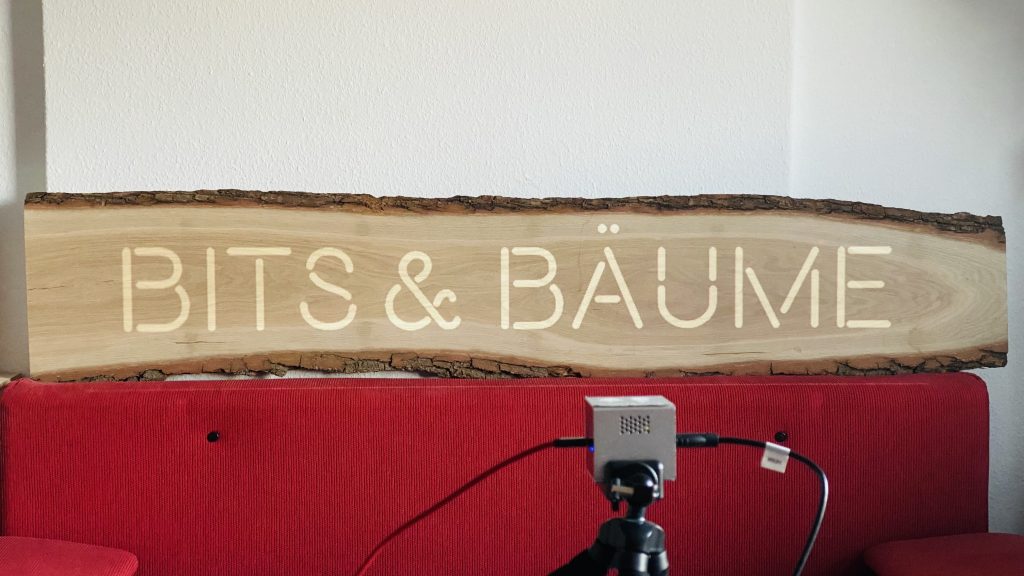
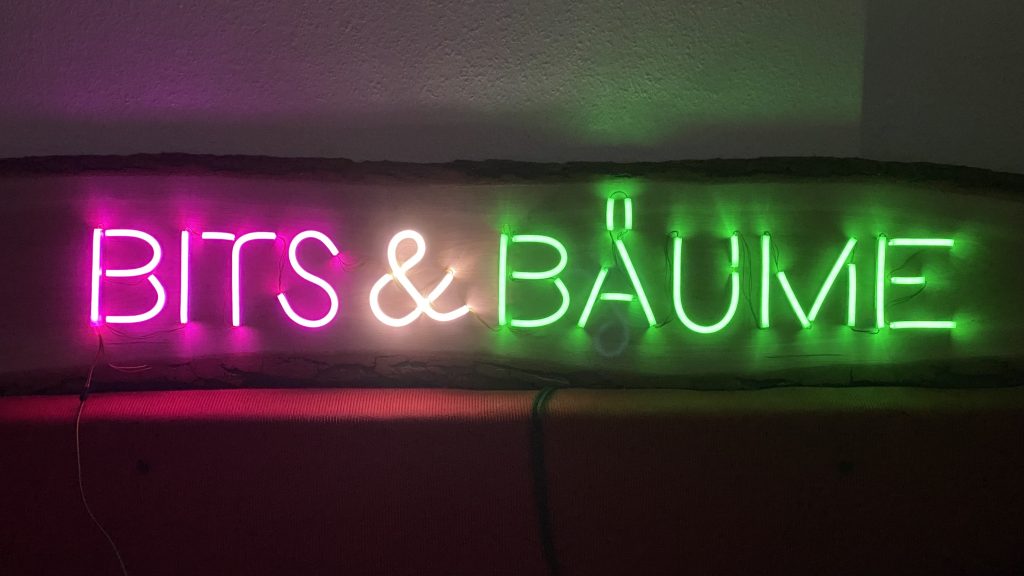
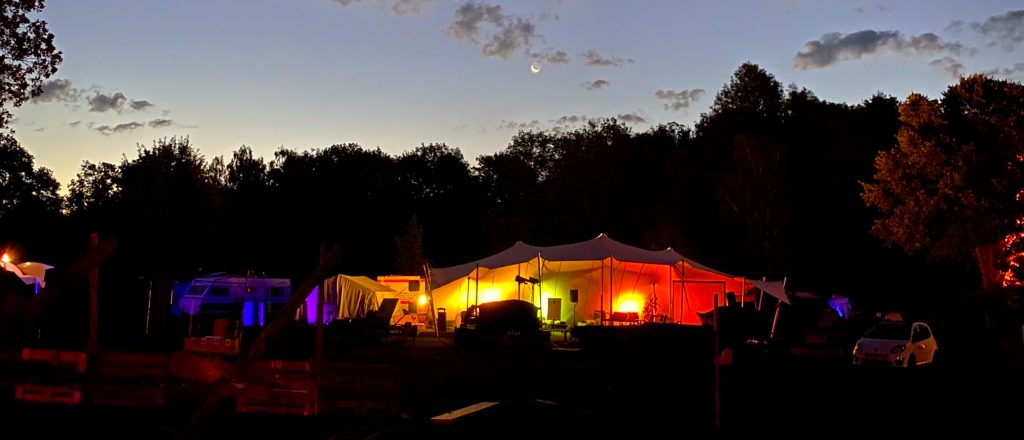
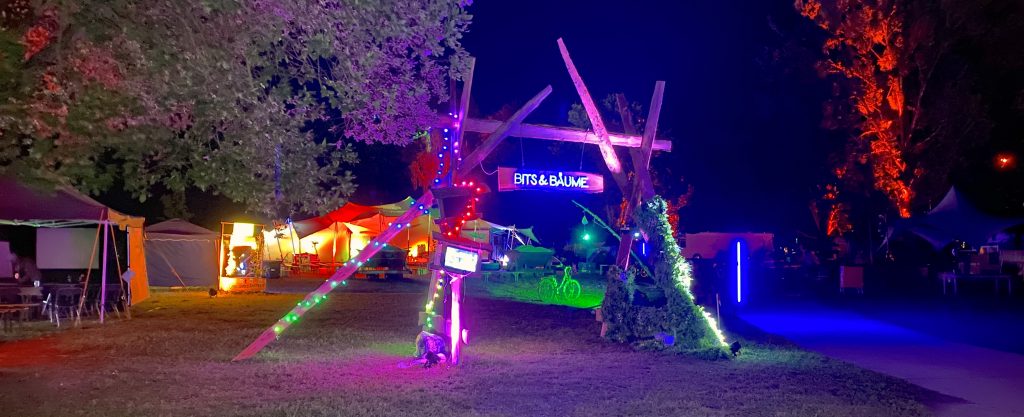
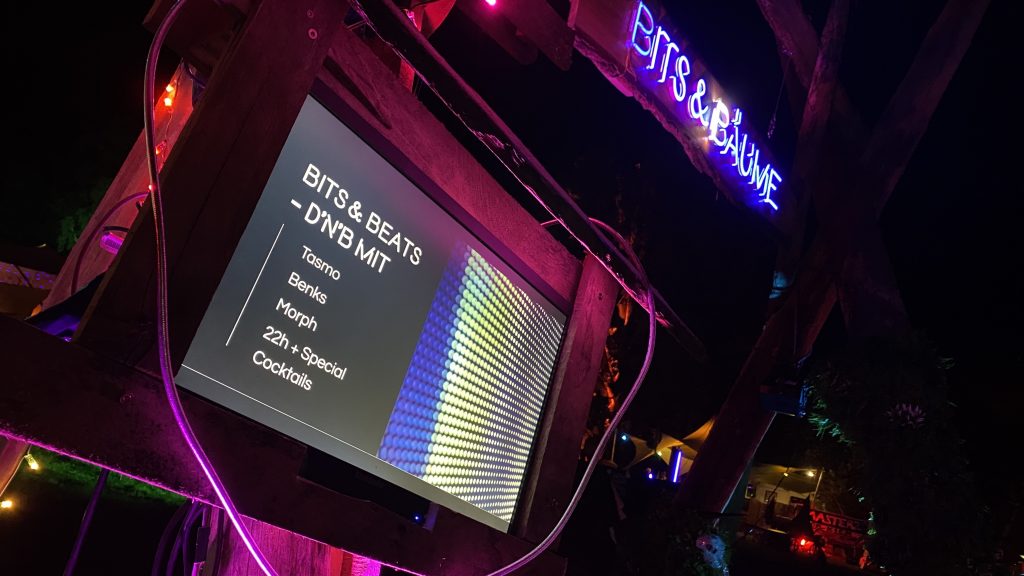

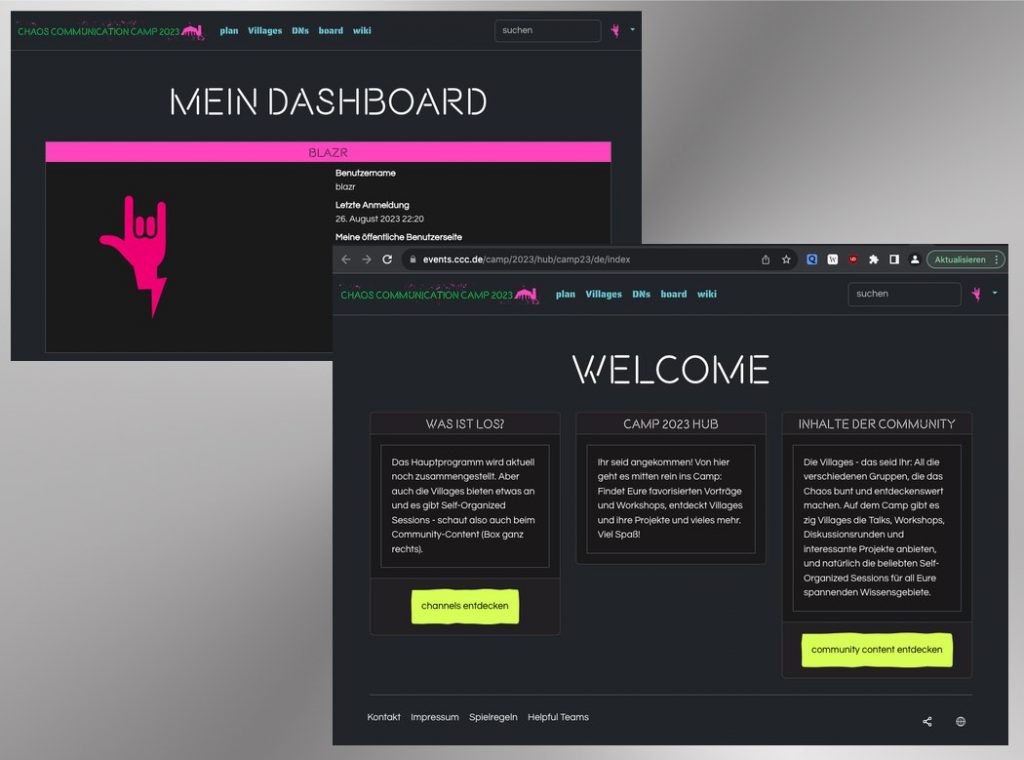
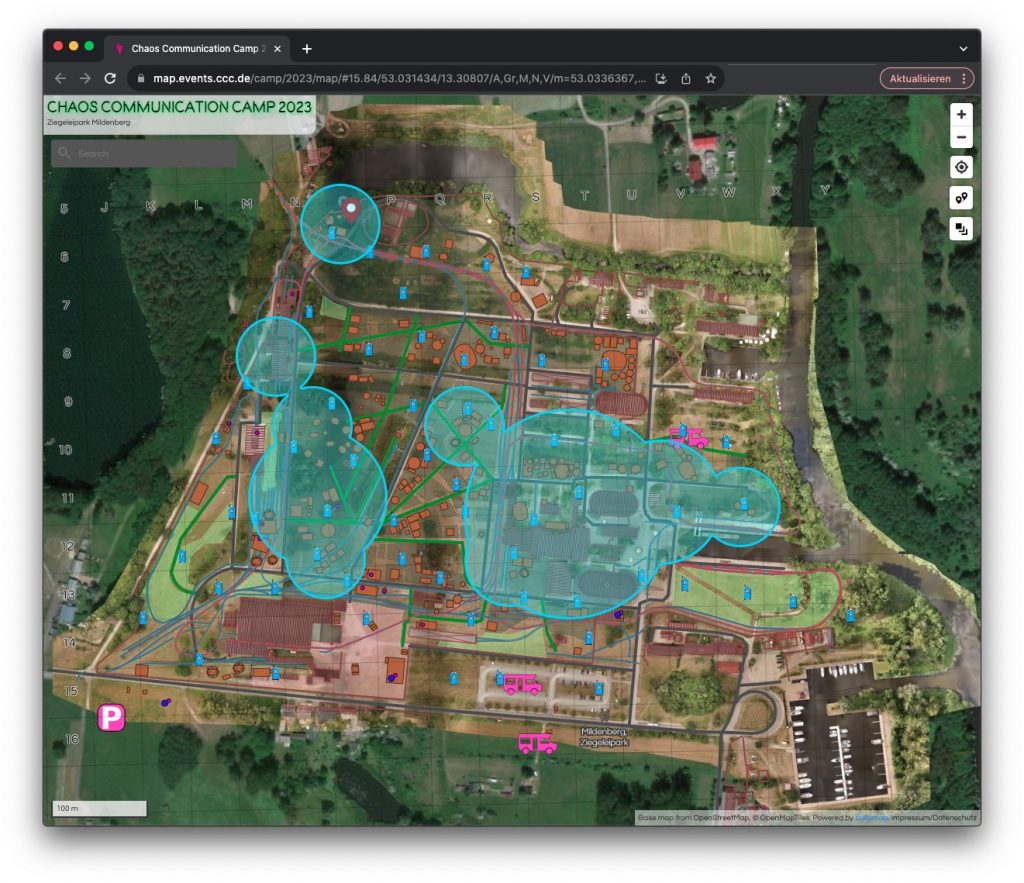
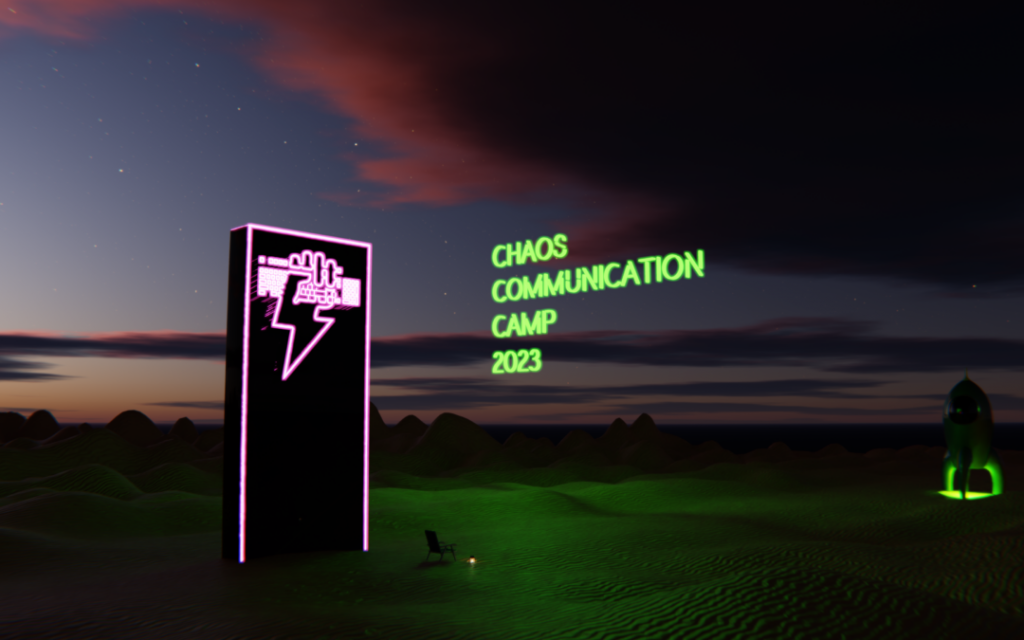

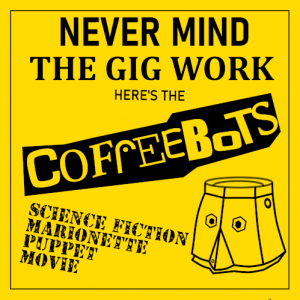

I understand, i even think i understand quite well, nevertheless i disagree strongly regarding the conclusion. Especially, since you already named most of the problems, with most of them being solvable. Well, many – because i guess since its a hackercamp, it will always be noisy, more or less.
My guess is that with better tent location and stress reduced arrival, at least some issues are solvable. Personal experience: its fine to finish a project and bring it to the camp. Also totally fine: finishing half of it and getting the rest done togehter with others on site. I’d recommend this strategy before being stressed out before even arriving.
I totally agree on the wiki issue (what a surprise). I wasn’t as frustrated on the toilet/shower situation (well, YMMV on that), nevertheless, i am sure people will learn from it. I did not actually understand the split of camp/Bits and Bäume and i guess that there should be a better solution as the one we had, since i found the B&B-part of the camp great and inspiring. And kids… well, we fork processes. Not my world either, usually. And if its not: my guess would be that its an „on top issue“ which would be ok, wouldn’t everything else have been frustrating.
I hope you change your mind until the next camp, be it Netherlands or CCC. Regarding post camp trauma: this: https://www.korrupt.biz/557/zu-den-belgiern-auf-dem-ccc-camp/ was my first, if i remember correctly, and you are warned about the soundcloud link there, but i tell you: so it was, the whole night through. Yet here i am. Klagt nicht, campt!